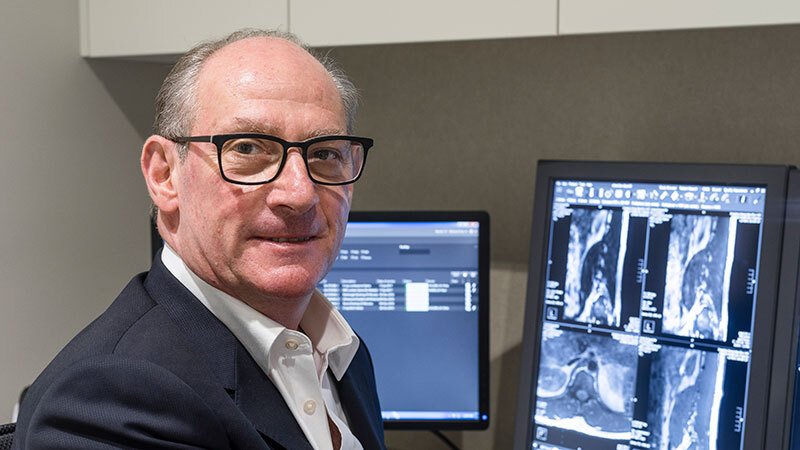From wine to $8.75 billion success story, Pro Medicus is embracing AI after 40 years at forefront of medical imaging

The Pro Medicus co-founders bonded over wine in the 1980s. Pic: Getty Images
- Pro Medicus celebrates 40 years of business, growing to a $8.75 billion market cap
- Co-founder Dr Sam Hupert says medical imaging increasingly important in diagnostics
- Hupert says artificial intelligence is well suited to medical imaging
A shared passion for Burgundy wine united now Australian billionaires and founders of health imaging company Pro Medicus (ASX:PME) Dr Sam Hupert and Anthony Hall, who met at a wine tasting event back in the early 1980s.
Founded 40 years ago PME has become an Australian biotech success story with its “anti-radiologist burnout tool”. Their initial inspiration was to harness the potential of emerging computer technology to benefit doctors.
PME introduced secure email and digital systems for medical professionals in Australia and in the early 1990s secured one of Australia’s first internet domain names.
Hupert and Hall seized the opportunity when the price of silver soared, causing X-ray film costs to rise and prompting radiologists to increasingly rely on computers.
Operating from the same building in Melbourne for nearly a quarter of a century, PME listed on the ASX in 2000, made some game-changing acquisitions and now has a market cap of $8.75 billion with the co-founders each maintaining a significant 25% ownership.
PME recently announced its wholly owned US subsidiary, Visage Imaging, had won a $140m, 10-year contract with Baylor Scott & White Health (BSWH), the largest not-for-profit healthcare system in Texas and one of the largest in the US.
As PME celebrates its 40-year anniversary Stockhead caught up with Hupert to talk about the company’s journey so far and plans as technology and artificial intelligence (AI) play an increasing role in medical diagnostics.

PME was established by you and Anthony Hall who you met at a wine tasting function in the early 1980s. With a market cap of ~$8.75 billion were you always confident the company and your software had the ability to grow so much?
“When you start a business, you always hope that it will be successful, but I don’t think back then we imagined it would be what it is now but I suppose that is a good thing,” Hupert says.
“It encourages us to look forward.”
PME has operations globally. How do you see the worldwide medical imaging market currently and into the future?
“It’s growing because imaging is forming a greater part of the diagnostic process and will continue to do so for the foreseeable future,” Hupert says.
“In the past they talked about an EHR, an electronic health record.
“Now they are talking about an IHR, an imaging health record, that’s how important imaging is becoming.
“In addition, there are new technologies and emerging countries where imaging is becoming more prevalent, so globally the market is expanding.
“I can only see that it will continue to expand in the future.”
What impact do you foresee the emergence of artificial intelligence having on health imaging?
“AI is very well-suited to healthcare, and imaging in particular,” Hupert says.
“Of the FDA-cleared algorithms in healthcare, the majority are currently related to imaging – a trend that I think will continue, because imaging is all about pixel/pattern matching, something AI is very good at.”
What does the emergence of the cloud as a host for high-volume image libraries mean for patients, clinicians and the sector?
“For our clients – the larger imaging groups and hospitals – cloud is an inevitability given the scale and security requirements of our industry,” Hupert says.
“I think that has a flow-on effect for both patients and clinicians in terms of ease-of-access to images and the possibility of further analytics including AI.”
You trained and worked as a medical doctor before realising the significant potential for computers in medicine and leaving general practice in late 1984 to devote yourself full time to managing the company. Do you miss general practice and how has that experience helped you in your role building Pro Medicus to the company it is today?
“I enjoyed general practice but as things started to get busy at Pro Medicus I had to make a decision and I have never looked back,” Hupert says.
“Having said that, you had to be a doctor to do what I have done and I use my medical background in what I am doing today.
“The difference is that when I was in clinical practice I would interact with my patients on a ‘one on one’ basis.
“At Pro Medicus, we move the needle clinically, so we touch tens millions of patients, but on a one to many basis.”
You and Anthony Hall are well recognised for being financially conservative with the growth of PME and have said you successfully secured funding for an exceptionally costly software development project during the 1980s by striking a deal with Digital Equipment Corp, which at the time was the second-largest computer company globally behind IBM. Do you think that other smaller biotechs could learn from your financial conservatism, especially during these times of higher funding costs?
“Firstly, it was a totally different time back then,” Hupert says.
“The VC market was almost non-existent, unlike today where it has become the norm for many founders to seek this type of funding.
“Regardless of the type of funding I do think there is a role for financial conservatism that enables founders to retain greater equity, and therefore greater control of their destiny.
“So, whilst VC funding may suit some, it is not necessarily the best avenue for all.”
PME has been focused on radiology where about 600 million X-rays are done annually in the US and you’ve got a market share of about 5-6% with your product best in class. However, PME has also flagged moving into other “ologies” such as cardiology, dermatology and pathology where images are used and your software could be useful in helping clinicians with analysis. How do you think PME could help these other ologies and what would expansion into these different areas mean for the company?
“Up until now imaging in the various departments of hospitals was heavily siloed, with each department having its own separate system that in many cases did not integrate or communicate with other systems within the enterprise,” Hupert says.
“What we are looking to do hasn’t been done before, in that we are looking to use the same platform – in our case the Visage platform – and extend its feature functions to cover the other ‘ologies’ outside radiology.
Our first target is cardiology, which uses the same imaging equipment as radiology – ultrasound, CT, MRI and nuclear. Radiology and cardiology are, for wont of a better description ‘first cousins’.
“Once you get outside radiology and cardiology, the majority of images are reflective light, photos or videos, often captured by specialised equipment such as a dermascope for dermatologists or a slit lamp for ophthalmologists.
“Smartphones have also meant that an exponentially increasing number of photos and videos will now form part of the patient record.
“We are looking to extend the use of Visage to these other -ologies over time, ensuring that one system can serve up any image within the healthcare enterprise.
“It is hard to accurately quantify how big this opportunity is, given that most healthcare institutions don’t fully know how many images they have, particularly when it comes to photo and video, but we estimate that it could produce between 30-50% additional revenue on top of radiology.”
The ASX biotech sector has had a tough 18 months or so with the S&P/ASX 200 Healthcare index (ASX:XHJ) down ~9% YTD but PME is up more than 50% for the same period. How has PME managed to navigate this tough period to keep its share price performing so strongly?
“I can’t comment on our share price other than it is determined by the market. Having said that, we think we are in a good position for several reasons,” Hupert says.
“Firstly, healthcare is largely non-discretionary, so we are not affected as much by interest rates and inflation as compared to more consumer-facing businesses.
“We also are financially conservative and have no debt, so rising interest rates do not impact us.
“If anything, they are good for us as we get a better return on our cash reserves.
“Having said that, I think the most important thing is, despite a tough global market backdrop, we have shown we have been able to continue our profitable growth trajectory.”
What advice do you have for those investing in the biotech sector either in Australia or internationally?
“I am not an expert in this area by any means, but Australia does have a very vibrant biotech sector, one that is much larger than you would expect from a population of our size,” Hupert says.
“That said, scientific discovery means that even if the core technology is ‘a winner’ there is a long road to commercialisation.
“Having a good idea is not enough and you need an experienced management team to bring that idea to fruition.
“That applies particularly to biotechnology, both in Australia and internationally.”
The PME share price today:

UNLOCK INSIGHTS
Discover the untold stories of emerging ASX stocks.
Daily news and expert analysis, it's free to subscribe.
By proceeding, you confirm you understand that we handle personal information in accordance with our Privacy Policy.








